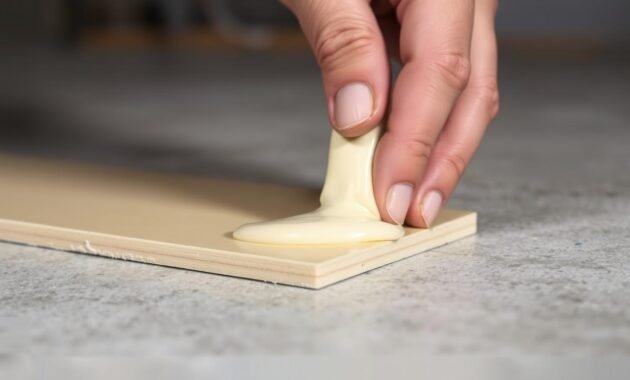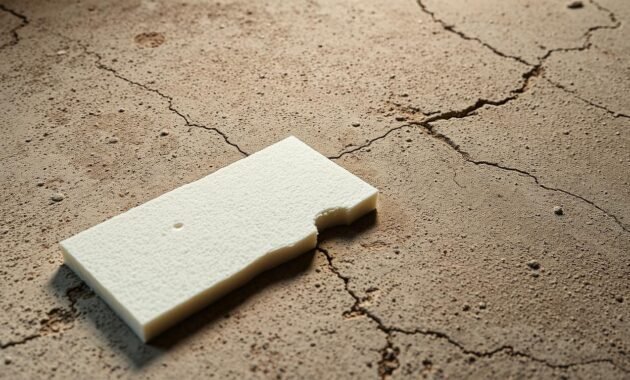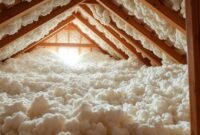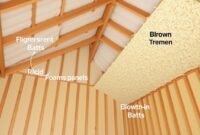Many DIY fans and pros struggle to stick foam board to concrete. The wrong glue can cause weak bonds, damage, and expensive fixes. Foam board is soft, and concrete is rough, making it hard to bond them well.
I’ve worked on many adhesive problems and know how important the right glue is. It’s not just about sticking two things together. It’s about making a strong, lasting bond that can handle the weather.
In this guide, I’ll share my top picks for sticking foam board to concrete walls. You’ll learn about professional-grade adhesives that make strong, reliable bonds for your projects.

Understanding Foam Board and Its Applications
Foam board has changed the game in construction and DIY projects. It’s a material that stands out for its versatility. Knowing what glue to use on foam board is key, given its unique properties.
What Makes Foam Board Unique
Foam board’s secret is its special mix. It has a core made of 95-98% air. This makes it incredibly light, yet strong and great for keeping things warm or cool.
- Incredibly lightweight
- Surprisingly rigid and sturdy
- Excellent insulation properties
- Easy to cut and shape
Common Uses in Construction and DIY Projects
Foam board is used in many ways. It’s perfect for making architectural models or insulating homes. Choosing the right glue is important, depending on how you plan to use it.
Read also: Should I Insulate Interior Walls?
Benefits of Using Foam Board on Concrete
Working with concrete can be tough. Foam board makes it easier. It’s great for keeping things warm or cool, doesn’t add much weight, and is smooth for finishing.
- Superior thermal insulation
- Minimal added weight to existing structures
- Smooth surface for further finishing
- Excellent sound dampening qualities
Choosing the right glue is vital for foam board to work well. The wrong glue can ruin its performance. So, it’s important to pick the right one for your project.
Essential Considerations Before Applying Adhesive
Learning how to attach foam board to concrete involves several key factors. Not all adhesives are the same. The wrong choice can ruin your project.

First, figure out how much adhesive you need. The right amount depends on the surface and project size. Measure your foam board and concrete carefully to get it right.
- Check the surface texture of your concrete (smooth or rough)
- Evaluate the concrete’s moisture levels
- Consider temperature and humidity conditions
- Inspect the foam board’s material composition
Chemical compatibility is also important. Some adhesives can harm foam board, making it weak. Water-based glues might warp or damage the board’s surface. So, picking the right adhesive is key.
Professional tip: Always test a small area first. This ensures the adhesive works with your foam board and concrete. It’s a simple step that can prevent big mistakes and ensure success.
Best Adhesive for Foam Board to Concrete: Top Recommendations
Finding the right adhesive is key for foam board on concrete. I’ve tried many products to find the best ones. The right adhesive depends on your project’s needs, size, and the surface.
Looking for the best adhesive for foam board? You’ll find many strong options. These adhesives create lasting bonds.
3M 90-24 Hi-Strength Spray Adhesive
The 3M 90-24 Hi-Strength Spray Adhesive is my top pick. It bonds foam board to concrete well. It’s quick-drying, versatile, and strong.
- Quick-drying formula
- Versatile application
- Strong initial and long-term adhesion
- Suitable for various foam board types
Construction Grade Adhesives
Construction-grade adhesives are great for precise work. They come in tubes and bond well to foam board.
| Adhesive Type | Strength Rating | Best For |
|---|---|---|
| Polyurethane Construction Adhesive | High | Large surface areas |
| Epoxy-Based Adhesive | Very High | Structural applications |
| Acrylic Construction Adhesive | Medium | Indoor projects |
Heavy-Duty Contact Cement Options
For big projects, heavy-duty contact cement is the best. It makes a very strong bond between foam board and concrete.
Always prepare your surface well and follow the adhesive’s instructions. This will help you get the best results.
Surface Preparation Techniques for Maximum Adhesion
Learning how to attach foam board to a concrete wall starts with surface preparation. This step is key to a strong bond between the foam board and the concrete. Proper preparation is essential for a lasting installation.

Before attaching a board to concrete, clean the surface thoroughly. Here are the important steps:
- Remove all dust, debris, and loose particles from the concrete surface
- Check for moisture using a moisture meter
- Repair any cracks or uneven areas with concrete patch
- Sand smooth surfaces to improve adhesive grip
Temperature is also important for adhesion. Make sure the concrete wall and foam board are between 50-90 degrees Fahrenheit. This range ensures the best bonding. Extreme temperatures can weaken the adhesive.
| Preparation Step | Tools Needed | Time Required |
|---|---|---|
| Surface Cleaning | Wire brush, vacuum | 15-30 minutes |
| Moisture Check | Moisture meter | 10-15 minutes |
| Surface Smoothing | Sandpaper, sander | 30-45 minutes |
Spending time on surface preparation is worth it. It sets the stage for a secure and lasting foam board installation on your concrete wall.
Application Methods and Best Practices
Attaching foam board to concrete needs precision and the right method. I’ll guide you through the key steps for a successful installation. This will help you learn how to attach foam board to concrete.
Step-by-Step Application Guide
When picking glue for foam board, follow these important steps:
- Clean the concrete surface well, removing dust and debris
- Choose the right adhesive for your project
- Spread the adhesive evenly with a roller or the right tool
- Press the foam board firmly onto the concrete
- Use a level to check if it’s straight
Common Application Mistakes to Avoid
I’ve seen many DIYers make big mistakes during foam board installation. Here are common errors to watch out for:
- Not preparing the surface well enough
- Applying adhesive unevenly
- Not pressing hard enough when installing
- Ignoring temperature and humidity advice
Safety Precautions During Application
Always put safety first when using adhesives. Wear gloves, safety glasses, and a respirator. Work in a place with good air flow and follow the instructions closely. Keep adhesive away from heat and sunlight.
By following these tips, you’ll get a professional-looking foam board installation on concrete. It will look great and last a long time.
Environmental Factors Affecting Adhesive Performance
Choosing the right adhesive for foam board to concrete needs understanding of environmental factors. Temperature, humidity, and exposure greatly affect adhesive performance. Knowing these factors helps determine how much adhesive you’ll need.
Different environments need different adhesive strategies. Cold temperatures slow down curing, while high humidity can prevent bonding. The right adhesive depends on your environment.
- Temperature Range: Most adhesives work best between 60-80°F
- Humidity Levels: Aim for 40-60% relative humidity
- Direct Sunlight Exposure: Can degrade certain adhesive types
When figuring out how much adhesive you need, consider these challenges. In tough conditions, you might need more adhesive or specialized products.
Moisture is a big problem for foam board installations. Indoor areas with steady temperature and low humidity work best. Avoid using foam boards in wet places like bathrooms or kitchens.
Always check the manufacturer’s specs for temperature and humidity before starting. This ensures the best adhesion and lasting results.
Alternative Mounting Solutions and Backup Methods
Working with foam board and concrete doesn’t always mean using adhesives. Sometimes, you need more support or different ways to mount things securely. I’ll show you some strong alternatives to attach a board to concrete, giving you extra stability and confidence.
Mechanical fasteners are a great backup for securing foam board. They’re key when you’re working with heavy materials or surfaces that adhesives can’t handle.
Read also: How to Attach Rigid Foam Insulation to Studs
Mechanical Fasteners as Support
Here are some mechanical fastening techniques to consider:
- Concrete anchors for direct wall attachment
- Expansion bolts for heavy-duty support
- Masonry screws designed for concrete surfaces
- Wall plugs that create a strong connection point
Hybrid Installation Approaches
Using the best adhesive for foam board to wood often means mixing different mounting methods. A hybrid approach can make your installation stronger and more durable. This might involve using both adhesive and mechanical fasteners for a solid mounting solution.
For example, you could use a top-notch construction adhesive and then add concrete anchors. This way, you get more points of contact and lower the chance of failure.
- Combine adhesive with mechanical fasteners
- Use furring strips for additional support
- Create multiple attachment points
- Select fasteners compatible with both foam board and concrete
Remember, your project’s needs will guide the best mounting solution. Always think about the weight, surface condition, and environmental factors when choosing your attachment method.
Troubleshooting Common Installation Issues
Learning to attach foam board to a concrete wall can be tricky. Even with good planning, problems can pop up. These issues can test your DIY skills.
Let’s look at some common problems with foam board adhesives. We’ll also talk about how to fix them fast and well.
- Adhesive Not Setting Properly
- Check temperature and humidity levels
- Ensure surface is completely clean and dry
- Use a heat gun to activate some adhesives
- Foam Board Peeling from Concrete
- Reapply adhesive with even pressure
- Sand surface before reapplication
- Consider using mechanical fasteners for additional support
- Bubbles Forming Under the Board
- Use a roller to press out air pockets
- Apply adhesive in thin, even layers
- Work in small sections to prevent air trapped underneath
When picking the best adhesive for foam board, test it first. Different concrete surfaces need different adhesives. Some concrete walls are more porous or have slight irregularities that can affect adhesion.
Pro tip: Always have extra adhesive and cleaning supplies ready. This can save you time and stress if problems come up during your foam board project.
Conclusion
I’ve shown you how to pick the best adhesive for foam board to concrete. We’ve covered everything from foam board’s special features to finding the right adhesive for your project.
Choosing the right adhesive isn’t simple. It involves understanding surface prep, environmental factors, and how to apply it. This ensures a strong, lasting bond. Professional results come from careful planning and precise execution.
Whether you’re insulating your home, doing a DIY project, or working on a commercial job, you now have the knowledge to install foam board confidently. Each project is different. Taking time to choose the right adhesive and prepare surfaces properly will greatly improve your results.
My advice is to go over the techniques we’ve talked about. Then, think about what your project needs. Approach your foam board installation with patience and precision. With the right steps, you’ll have a secure and professional installation that lasts.


